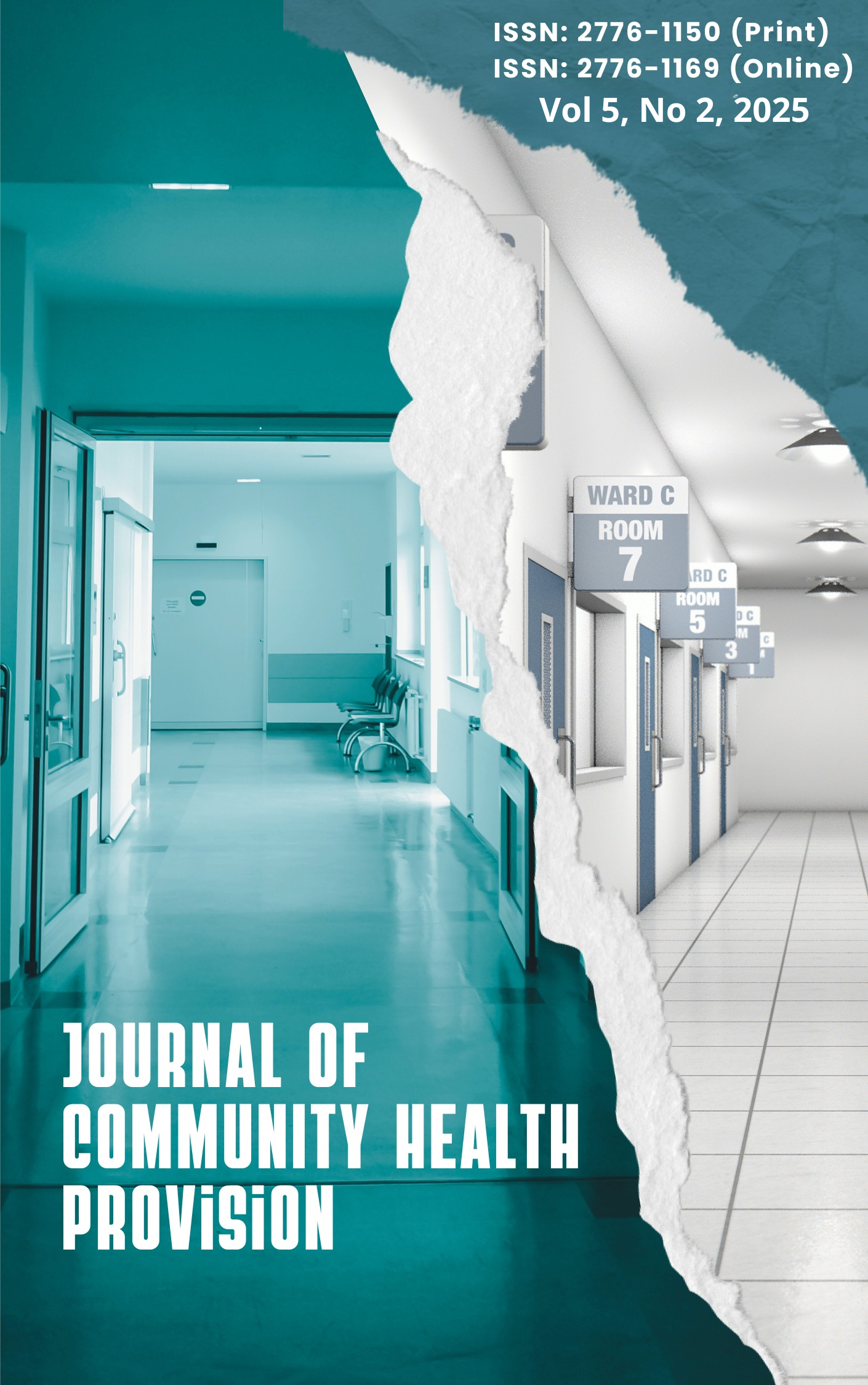Analysis of Factors Affecting Compliance Treatment of Pulmonary Tuberculosis Patients in the Work Area
Main Article Content
Abstract
Article Details

This work is licensed under a Creative Commons Attribution-ShareAlike 4.0 International License.
References
Atif, M., Munir, K., Malik, I., Al-Worafi, Y. M., Mushtaq, I., & Ahmad, N. (2022). Perceptions of healthcare professionals and patients on the role of the pharmacist in TB management in Pakistan: A qualitative study. Frontiers in Pharmacology, 13, 965806. https://doi.org/10.3389/fphar.2022.965806
Caminero, J. A., Sotgiu, G., Zumla, A., & Migliori, G. B. (2010). Best drug treatment for multidrug-resistant and extensively drug-resistant tuberculosis. The Lancet infectious diseases, 10(9), 621-629.
Campbell, I. A., & Bah-Sow, O. (2006). Pulmonary tuberculosis: diagnosis and treatment. Bmj, 332(7551), 1194-1197. https://doi.org/10.1136/bmj.332.7551.1194
Collins, D., Hafidz, F., & Mustikawati, D. (2017). The economic burden of tuberculosis in Indonesia. The International Journal of Tuberculosis and Lung Disease, 21(9), 1041-1048. https://doi.org/10.5588/ijtld.16.0898
Conradie, F., Diacon, A. H., Ngubane, N., Howell, P., Everitt, D., Crook, A. M., ... & Spigelman, M. (2020). Treatment of highly drug-resistant pulmonary tuberculosis. New England Journal of Medicine, 382(10), 893-902. https://doi.org/10.1056/NEJMoa1901814
Falzon, D., Schünemann, H. J., Harausz, E., González-Angulo, L., Lienhardt, C., Jaramillo, E., & Weyer, K. (2017). World Health Organization treatment guidelines for drug-resistant tuberculosis, 2016 update. European Respiratory Journal, 49(3). https://doi.org/10.1183/13993003.02308-2016
Hevey, D. (2007). Adherence to health recommendations. In Cardiovascular prevention and rehabilitation (pp. 293-300). London: Springer London. https://doi.org/10.1007/978-1-84628-502-8_35
Hossain, M. R., Islam, M. S., Akter, S., Anisuzzaman, A. H. M., Abdullah-Al-Maruf, M., & Mohammed, N. (2023). Impact of education on non-compliance and MDR TB risk: specialized hospital study. Saudi J Med, 8(12), 659-663. https://doi.org/10.36348/sjm.2023.v08i12.007
Jonas, K., Crutzen, R., van den Borne, B., & Reddy, P. (2017). Healthcare workers’ behaviors and personal determinants associated with providing adequate sexual and reproductive healthcare services in sub-Saharan Africa: a systematic review. BMC pregnancy and childbirth, 17(1), 86. https://doi.org/10.1186/s12884-017-1268-x
Kurnianingsih, W., Tamtomo, D. G., & Murti, B. (2020). The effect of non-compliance with medication on multidrug resistant of tuberculosis. Journal of Epidemiology and Public Health, 5(4), 442-450.
Mobaderi, T., Kazemnejad, A., & Salehi, M. (2025). Clustering and modeling joint-trajectories of HIV/AIDS and tuberculosis mortality rates using bayesian multi-process latent growth model: A global study from 1990 to 2021. BMC Infectious Diseases, 25(1), 330. https://doi.org/10.1186/s12879-025-10715-x
Mukuka, B. (2024). A Study to Assess Anti-TB Treatment Compliance, Factors Predictive for Poor Adherence and Perpetual Defaulting among Patient Living with TB in Namuseche Chipata Eastern Province–Zambia. Mukuka Brian. https://doi.org/10.38124/ijisrt/IJISRT24OCT005
Nahid, P., Mase, S. R., Migliori, G. B., Sotgiu, G., Bothamley, G. H., Brozek, J. L., ... & Seaworth, B. (2019). Treatment of drug-resistant tuberculosis. An official ATS/CDC/ERS/IDSA clinical practice guideline. American journal of respiratory and critical care medicine, 200(10), e93-e142. https://doi.org/10.1164/rccm.201909-1874ST
Nezenega, Z. S., Perimal-Lewis, L., & Maeder, A. J. (2020). Factors influencing patient adherence to tuberculosis treatment in Ethiopia: a literature review. International journal of environmental research and public health, 17(15), 5626. https://doi.org/10.3390/ijerph17155626
Sari, Y. S., & Kamil, H. (2022). The patient with multi-drug resistant–pulmonary tuberculosis adherence to treatment: a qualitative study. Enfermería clínica, 32, S58-S61. https://doi.org/10.1016/j.enfcli.2022.03.019
Surendra, H., Elyazar, I. R., Puspaningrum, E., Darmawan, D., Pakasi, T. T., Lukitosari, E., ... & Hamers, R. L. (2023). Impact of the COVID-19 pandemic on tuberculosis control in Indonesia: a nationwide analysis of programme data and health system vulnerabilities. medRxiv, 2023-02. https://doi.org/10.1101/2023.02.09.23285740
Swarna Nantha, Y., Puri, A., Mohamad Ali, S. Z., Suppiah, P., Che Ali, S. A., Ramasamy, B., & Ibrahim, I. M. (2017). Epidemiology of latent tuberculosis infection among patients with and without diabetes mellitus. Family practice, 34(5), 532-538. https://doi.org/10.1093/fampra/cmx017
Uplekar, M. W., & Shepard, D. S. (1991). Treatment of tuberculosis by private general practitioners in India. Tubercle, 72(4), 284-290. https://doi.org/10.1016/0041-3879(91)90055-W
van Dulmen, S., Sluijs, E., Van Dijk, L., de Ridder, D., Heerdink, R., & Bensing, J. (2007). Patient adherence to medical treatment: a review of reviews. BMC health services research, 7(1), 55. https://doi.org/10.1186/1472-6963-7-55
World Health Organization, & World Health Organization Staff. (2013). Global tuberculosis report 2013. Switzerland: World health organization.
Zumla, A., Chakaya, J., Centis, R., D'Ambrosio, L., Mwaba, P., Bates, M., ... & Migliori, G. B. (2015). Tuberculosis treatment and management—an update on treatment regimens, trials, new drugs, and adjunct therapies. The Lancet Respiratory Medicine, 3(3), 220-234.

